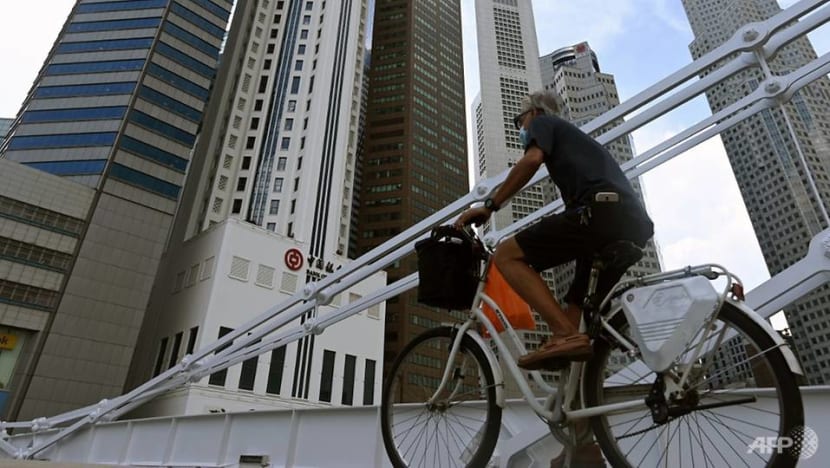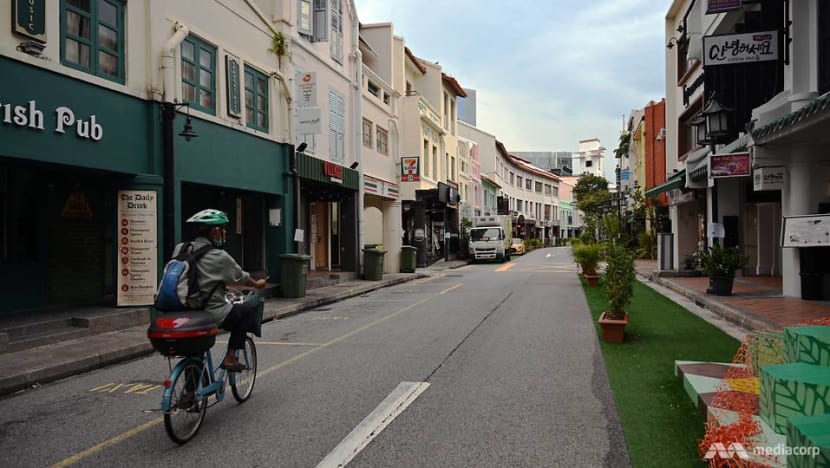Registration of bicycles, licensing of cyclists may not make roads safer, say observers

A man wearing a face mask cycles past buildings in the financial business district in Singapore on Jun 11, 2020. (Photo: AFP/Roslan Rahman)
SINGAPORE: Requiring cyclists to be licensed or bicycles to be registered may not have the desired effect of keeping roads in Singapore safe, say observers, noting that such measures may impede the country’s cycling vision.
Instead other efforts, such as putting greater emphasis on education, may bear more fruit in terms of keeping cyclists as well as other road users safe, transport experts told CNA.
Senior Minister of State for Transport Chee Hong Tat had said on Monday (Apr 12) that the rules around cycling on the roads would be reviewed, amid an increase in its popularity.
Among the measures to be studied by the Active Mobility Advisory Panel are the possibility of requiring cyclists to be licensed and bicycles to be registered.
Mr Chee noted however that any changes to current regulations would have to be done in a “balanced and fair” manner so as to avoid discouraging cycling.
READ: Panel to review rules on cycling on the road, registration of bicycles to be studied: Chee Hong Tat
REVIVING REGISTRATION
Bicycles were required to be registered here from the colonial era until 1982, when the practice was discontinued.
But over the years, there have been numerous calls to revive the licensing of the two-wheelers and their riders.
In 2013, former Nee Soon GRC Member of Parliament Lee Bee Wah had suggested that cyclists be required to take safety lessons before being issued licences.
The suggestion resurfaced in 2016, when numerous letters to the Straits Times forum called for registration as a means of deterring errant riders.
The Land Transport Authority (LTA) had responded to the letters saying it had studied licensing “very carefully”, but cited “practical difficulties” in implementing such a scheme.
Implementing and managing a licensing system would be too resource-intensive, said LTA then, adding that there are concerns riders would be discouraged from cycling as it would be too onerous to own a bicycle.
Similar reasons have been cited for the rejection of bike licensing requirements in other cities, such as Los Angeles and Seattle in the United States.
Still, there are other locales which have such schemes in place, such as Japan, where it exists largely as an anti-theft measure.
In Honolulu, cyclists have to pay a one-time US$15 (S$20) registration fee for all bicycles with wheels that are at least 20 inches in diameter. This move brings in a reported US$400,000 (S$534,950) each year for the Hawaiian capital.
READ: IN FOCUS: Why can't cyclists and motorists just get along?

REGISTRATION PROS AND CONS
There are a number of possible benefits associated with the registration of bicycles, said Dr Cecilia Rojas, whose research is focused on active mobility.
In addition to greater enforcement of safety regulations, registration could help reduce instances of bike theft as well as abandoned or illegally parked two-wheelers, noted the Singapore University of Social Sciences (SUSS) lecturer.
Any such scheme should have clear regulations regarding who needs to be registered, and be adopted gradually so as to give people enough time to adapt, she said, adding that the licensing process should be “straightforward and easy”.
But Dr Rojas added that it would be challenging to introduce a licensing framework that could cater to different types of cyclists, noting also there could be difficulties in implementing registration for different types of bicycles.
READ: Singapore sees cycling boom amid COVID-19, with increased ridership and bicycle sales
“Bicycles are bought, sold, exchanged very regularly. Also, in cases of road bicycles, sometimes just the frame or the handle or the wheels are changed, making the bicycle lighter or faster. Would these types of changes be required to be informed (to the authorities), or a new licence be required?” she asked.
The inconvenience of the process could deter people from cycling, she added, echoing Mr Chee’s concerns.
Although registration is required for e-bikes and e-scooters, transport expert Tham Chen Munn questioned how effective this has been in enhancing road safety.
Mr Tham, who is a business development director for traffic solutions firm PTV Asia-Pacific, questioned if the registration for these devices - which requires that they display an identification number - had assisted in catching errant riders.
Cycling advocate Francis Chu noted that e-scooters were eventually banned from footpaths despite requiring registration.
“On the roads, vehicles move faster and the distance between them is further apart compared to those on the pavement. If on the footpath it didn't help address the errant riders, it will be more difficult to capture the number plate on the road,” said the co-founder of cycling group Love Cycling SG.
Mr Chu suggested there could be a risk of drivers tailing errant cyclists so as to identify their number plates.
Speaking to the media on Monday, Safe Cycling Task Force president Steven Lim - a member of the Active Mobility Advisory Panel - had said the issue of errant cyclists is a “behavioural” problem, noting that there are also errant motorists despite the stringent requirements to obtain a driving licence.
READ: Electric bicycle riders must pass theory test to ride on roads under proposed changes to Road Traffic Act
MAKING ROAD CYCLING SAFER
Mr Chu, who also previously sat on the Active Mobility Advisory Panel, suggested cyclists could be required to take an online test on how to cycle safely on the road, while drivers could also be encouraged to take a similar test on how to react to cyclists on the road.
He said the LTA should consult experienced cyclists on “problematic areas”, adding that infrastructure such as protected bike lanes and junctions could be introduced in certain areas if space allows.
Speed limits in certain areas could also be reduced in certain areas to keep cyclists and pedestrians safe, said Mr Tham.
He pointed to the United Nations’ support for a 30kmh speed limit in “areas where vulnerable road users and vehicles mix in a frequent and planned manner” as part of its second Decade of Action for Road Safety, which begins this year.
This can be done in areas with a “high density of people walking and cycling”, he added.
“We're not talking about expressways, we're not talking about major arterials, leave those as they are. There are opportunities to (introduce a speed limit of) 30kmh in places that can be safe for people to come out and play and be more active,” he said.
READ: Commentary: Banning bicycles from footpaths won’t make poor cycling habits disappear
Dr Rojas of SUSS suggested that greater educational efforts, rather than a mandatory theory test, would best keep cyclists safe.
“My four-year-old - and many others - rides a bicycle and although he doesn't know how to read or write, and hence can’t take a theory test, he is aware that he should dismount and push at certain areas, (stay) on which side of the footpath to ride, where to wait for the green man and other bicycle regulations,” she said.
“This behaviour is obtained through education and encouragement.”
The burden of such educational efforts should not fall purely on cyclists, but also on all road users to “acknowledge, respect, and co-exist” safely, she said.
“Considering that the cycling rate, although increasing, is still relatively low in Singapore, campaigns of encouragement, information and education might be the best approach to improve safety and increase the active mobility rate.”














